#Jquery Basic
Explore tagged Tumblr posts
Text
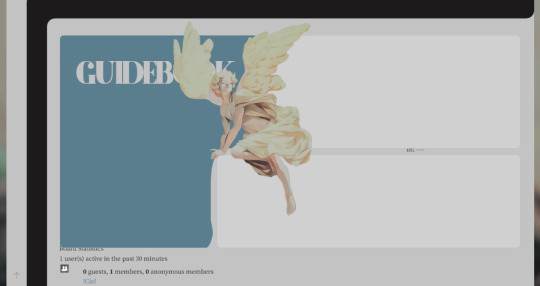
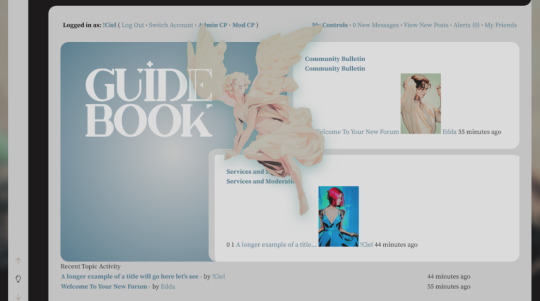
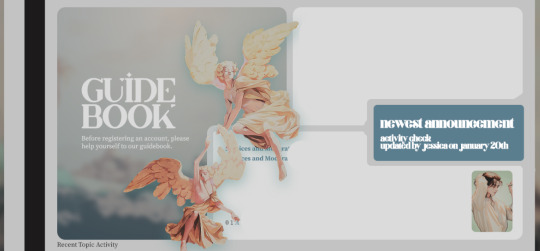
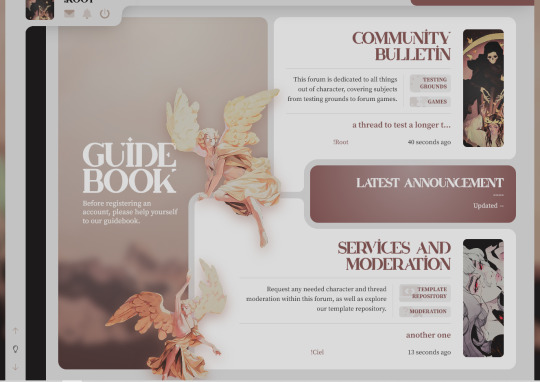
From crude mock-ups in photoshop to a finished-enough something, the sculpting process in skinning kind of looks a little like this for me. Its responsive-ish, which is pretty cool for someone who doesn't really have an interest in responsive design.
See how the mark-up for it is done on my codepen here. Design inspired by this little thing I saw on pinterest.
#wip: a midsummer nights dream#jcink skin#jcink codes#Been spending some spare time learning how to genuinely understand vanilla javascript & basic jquery for this project -#and its actually a little rewarding throwing what i've figured out into execution! more on that later.
43 notes
·
View notes
Text
Exploring jQuery: Your Gateway to Smooth Web Development on Webtutor.dev

In the vast landscape of web development, staying up-to-date with the latest technologies is essential to create dynamic and interactive websites. One such technology that has significantly influenced the way developers approach client-side scripting is jQuery. In this blog post, we'll delve into the world of jQuery, its features, benefits, and how it can make your web development journey smoother. And as a bonus, we'll introduce you to a fantastic learning resource, Webtutor.dev, that can help you master jQuery and other web development skills.
What is jQuery?
jQuery is a fast, small, and feature-rich JavaScript library that simplifies the process of adding interactivity and dynamism to web pages. It was created by John Resig in 2006 and has since become one of the most widely used libraries for front-end development. jQuery abstracts many complex tasks, allowing developers to achieve more with fewer lines of code.
Key Features of jQuery
DOM Manipulation: One of jQuery's primary strengths is its ability to manipulate the Document Object Model (DOM) effortlessly. Selecting, traversing, and modifying HTML elements becomes much more intuitive using jQuery's selectors and methods.
Event Handling: jQuery simplifies event handling by providing an easy-to-use interface to attach event listeners to elements. This allows developers to create interactive features like form validation, animations, and more, with less coding effort.
Ajax Support: Asynchronous requests are a fundamental part of modern web applications. jQuery's Ajax functions make it easier to fetch data from the server and update the web page without requiring a full refresh.
Animations and Effects: jQuery provides a range of built-in animation and effect functions that can be applied to elements. This includes fading, sliding, and other dynamic visual effects that enhance user experience.
Cross-browser Compatibility: One of jQuery's initial motivations was to simplify cross-browser scripting. It provides a consistent API across different browsers, making it easier to write code that works everywhere.
Plugin Ecosystem: jQuery boasts a massive collection of plugins created by the community, covering a wide range of functionalities. These plugins can save developers a considerable amount of time by providing pre-built solutions.
Read More: Step Up Your Coding Game with jQuery Benefits of Using jQuery
Saves Time: With its concise syntax and simplified APIs, jQuery reduces the time and effort required to accomplish common tasks.
Enhanced User Experience: jQuery's animations and interactive features can greatly improve the user experience of a website, making it more engaging and user-friendly.
Code Efficiency: Writing shorter, more readable code results in faster development cycles and easier maintenance.
Cross-browser Compatibility: jQuery takes care of browser-specific quirks, ensuring that your code works consistently across various browsers.
Community and Resources: Being one of the most widely adopted JavaScript libraries, jQuery has a massive community. This translates to a wealth of resources, tutorials, and plugins available for developers.
Learning jQuery with Webtutor.dev
If you're excited to learn jQuery and explore its capabilities, Webtutor.dev is your go-to resource. Webtutor.dev offers a comprehensive and interactive jQuery course that covers everything from the basics to advanced techniques. The course is designed to help you grasp concepts quickly through hands-on examples and practical projects.
Here's what you can expect from the Webtutor.dev jQuery course
Step-by-step Learning: The course takes you from the fundamentals of jQuery, gradually building your skills through real-world examples.
Interactive Coding: Interactive coding exercises ensure that you're actively engaged and can immediately apply what you've learned.
Projects: Practical projects help solidify your understanding and provide you with portfolio-worthy work to showcase your skills.
Supportive Community: Webtutor.dev fosters a community of learners where you can ask questions, share your progress, and learn from others.
Self-paced Learning: Learn at your own pace, fitting the course around your schedule.
Conclusion
jQuery remains a powerful tool in the toolkit of web developers, enabling them to create dynamic and interactive websites with ease. Its simplicity, cross-browser compatibility, and vibrant community make it an ideal choice for both beginners and experienced developers. To master jQuery and embark on an exciting web development journey, check out the jQuery course on Webtutor.dev and unlock your full potential as a web developer.
Visit Webtutor.dev to start your jQuery learning adventure today! Happy coding!
#JQuery Tutorials#Learn online JQuery#learn the basics of JQuery#Basics of JQuery Syntax#Learn Online jQuery#Online jQuery Tutorial#Introduction to jQuery
0 notes
Text

The 100% Good Twine SugarCube Guide!
The 100% Good Twine SugarCube Guide is a coding guide for the SugarCube format of Twine. It is meant as an alternative to the SugarCube documentation, with further explanations, interactive examples, and organised by difficulty. The goal of this guide is to make the learning curve for new SugarCube user less steep, and provide a comprehensive and wide look over the format.
VIEW / DOWNLOAD THE GUIDE!!!!
The Guide is compartmentalised in (currently) four categories:
THE BASICS or the absolute basics to start with SugarCube. No need for extra knowledge. Just the base needed to make something.
THE BASICS + adding interactivity, and creating a fully rounded IF game May require a bit of CSS knowledge (formatting rules)
INTERMEDIATE MODE adding more customisation and complex code Will probably require some CSS knowledge, and maybe some JavaScript
ADVANCE USE the most complex macros and APIs Will surely require some JavaScript/jQuery knowledge
Note: The Advanced Use includes all the APIs, macros, and methods not covered by the previous categories. This includes code requiring very advance knowledge of JavaScript/jQuery to be used properly.
Each category explains many aspects of the format, tailored to a specific level of the user. More simpler explanations and examples are available in earlier chapters, compared to the later ones.
If something is unclear, you found a mistake, you would like more examples in the guide, or would like a feature covered, let me know!
The Guide currently covers all macros (as of SugarCube v.2.37.3), all functions and methods, and APIs. It touches upon the use of HTML, CSS, JavaScript and jQuery, when relevant. It also discusses aspects of accessibility.
The Guides also provides a list of further resources, for the different coding languages.
The Guide is available in a downloadable form for offline view:
HTML file that can be opened in Twine
.tw file that can be opened in Twine
source code, separating the chapters, .js and .css files
GITHUB REPO | RAISE AN ISSUE | TWINE RESOURCES TWEEGO | TEMPLATES | CSCRIPT 2 SG GUIDE
Twine® is an “an open-source tool for telling interactive, non-linear stories” originally created by Chris Klimas maintained in several different repositories (Twinery.org). Twine is also a registered trademark of the Interactive Fiction Technology Foundation.
SugarCube is a free (gratis and libre) coding format for Twine/Twee created and maintained by TME.
VIEW / DOWNLOAD THE GUIDE!!!!
As of this release (v2.0.0), it is up to date with the version 2.37.3. If you are looking for the guide covering SugarCube 2.36.1, you can find it on my GitHub.
Note: the Guide is now complete. There won't be further substantial updates.
#the 100% Good Twine SugarCube Guide#template#templates#guide#coding in twine#twine#coding#HTML#JavaScript#CSS#macros#interactive fiction#sugarcube#interactive games#k thanks. i don't need any more reminders that sugarcube update and that I NEED TO UPDATE MY RESOURCES#i KNOW#manonamora
505 notes
·
View notes
Text


Day 18/ 100 Days of Code
The past few days, I've been alternating between hitting the books and resting. It has taken me such a long break to recharge ^^'
That's the thing about living with chronic fatigue: it's hard to keep a steady routine. I'm trying to do my best while I got the energy.
I started reading JavaScript and JQuery: Interactive Front-End Web by Jon Ducket, and I'm truly enjoying the content. I find it well structured and easy to follow, it can totally be used as a manual for anyone starting with programming.
Currently I'm practicing JS Basics by completing small challenges, I keep finding myself checking the MDN site for references. I don't know how I'll be able to remember all the JS syntax and methods; there's so much to grasp!
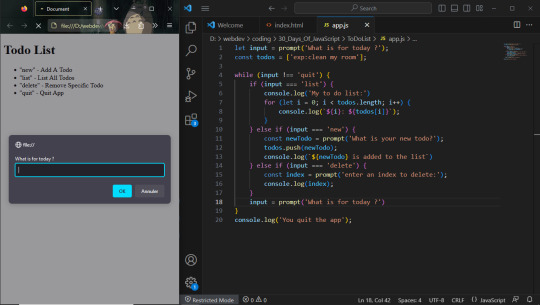
#100 days of code journal#learning#coding#webdevelopment#codeblr#studyblr#growing#imporving#self improvement#cs#computer science#programming#codenewbie#tech#learn to code#frontend#100daysofcode#coding blog#htlm#css#JavaScript
129 notes
·
View notes
Text

Learn the basics of web development with this HTML tutorial for beginners. Easy-to-follow guide to creating web pages with headings, links, and images. Perfect for new developers starting out!
2 notes
·
View notes
Text
Best Web Designing Institute in Khanna

The most in-demand skill globally is web design. In Anu InfoTech institute you'll master the fundamentals of design, including typography, color theory, and branding, all of which are crucial to the design of websites. You'll also learn how to create stunning websites. Additionally, you'll master HTML and CSS, which are the standard programming languages used to create all contemporary websites. These are helpful abilities to develop because almost every company in the world uses them to communicate with clients. By the time you complete this track, you'll be equipped with the knowledge and abilities needed to create your own websites, work for one of the millions of website-owning businesses, or even launch your own business.
Websites and pages are created through web designing to reflect a brand, provide information, and guarantee a user-friendly experience. Whether you're updating an existing website or running a blog, the look and feel of the site are essential elements. You can either learn web design to build your own website or work as a web designer building websites for other people. In this article, we define web design and discuss its common components and applications.
Web Designing Course Syllabus:-
Basics of Web Designing
HTML
CSS 3
JavaScript
jQuery
Responsive Designing
For more information visit - https://www.anuinfotech.com
2 notes
·
View notes
Text
Because I generally have always done backend development with Java and Python I haven't had to use HTML5, CSS3, or vanilla javascript much. Well, it's time to fix that! I have started to follow a YouTube series that teaches how to make responsive websites using HTML5, CSS3, JS & jQuery, and Bootstrap. I know the basics but need to grow more in the frontend space.
4 notes
·
View notes
Text
Toggle Script for Whatever You Need
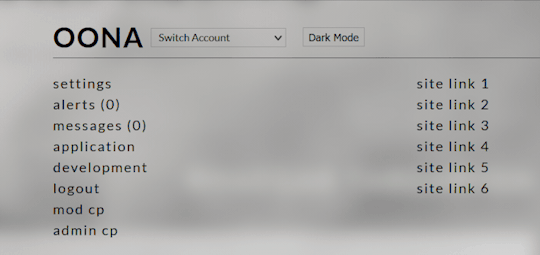
I have a couple buttons members and guests can click in order to change their settings on my site, and I've posted a tutorial on how to implement one here. One on my site is for low graphics (basically turns animations and gifs off in most places) so that if someone is on their phone or an older computer or a slower network they can make their experience a little better. Another is for light/dark mode once I actually finish testing light mode. This tutorial is basically just some simple jquery and an explanation of how to use css properly to change any css based features on a site and store that information for your users. Like my other scripting stuff, it's probably best to use this if you already have a decent idea of how css and jquery work, but this one is simpler than the memberlist setup for sure. Hope this is helpful for people!
4 notes
·
View notes
Text
random thoughts..
I refuse to use chatgpt to write code for me - I'm still learning to type pure JS and jquery by heart.
But it just pointed out a mistake that Prettier.io wouldn't tell me how to fix and I was at a loss - and it optimised 22 lines of code into 11, and I learned a lot. I am very sceptical about ai, and while it's just machine learning for now, this is very helpful on basic stuff. also you REALLY need to be specific to get the proper programming help lmao.
3 notes
·
View notes
Text
The Best Programming Languages For Beginners

When choosing the right programming language, it’s essential to consider your goals and career. You want to make sure that you choose a programming language that is both in demand and easy to learn. Python is an ideal choice for beginners because it reads like English and has a simplified syntax. It’s also versatile and can be used for anything from web development to software development.
Python
Python is a popular general-purpose programming language that’s easy to learn for beginners and widely used in web development, machine learning, art, automation, and more. It also has a vast community of resources that are available to new programmers.
Java is another widely used programming language, especially for mobile app development. It’s used at companies of all sizes (including HubSpot!) and is one of the easiest to learn if you want to develop for a variety of platforms.Better is to click here or visit our official website to know about Programming question answer.
C is an older programming language but still a good choice for beginners because it’s more “machine-level” and gives you the lowest-level control over computer hardware. It’s also the most common base for other languages, like C# and Ruby.
Java
Despite being not as beginner-friendly as Python, Java is a good programming language to start with. It's a general-purpose programming language with a versatile library and free online tutorials.
It's also a cross-platform language, which makes it suitable for mobile and desktop applications. It's the language of choice for Android development and used in a number of enterprise-level software applications.
C is one of the oldest languages and forms the basis for modern languages like Python, Java, and JavaScript. However, it has a low level of abstraction and requires that code is compiled (translated into machine-readable code) before it can be run. This can make it difficult for beginners to understand. Moreover, its syntax can be confusing. But, it's an excellent foundation for more advanced language learning.
Many people are interested in learning programming, but choosing the best language can be intimidating. Luckily, there are plenty of resources to help you get started. You can learn the basics of multiple languages with a coding boot camp, such as the Georgia Tech Coding Boot Camp, which offers a variety of courses including HTML, JavaScript, and jQuery.
Other popular languages include C, which is a general-purpose, compiled language that’s widely used in back-end software applications like web servers. Python is a versatile programming language that’s easy to learn for beginners and can be used in any application. Ruby is a dynamic, object-oriented language that’s commonly implemented using the Rails framework. Its concise syntax and convention-over-configuration approach makes it easier to build and deploy apps.
Perl
Perl is a high-level dynamic general-purpose scripting language. It is popular among system administrators for its text-processing capabilities, specifically its own in-built version of regular expressions. It is also used for web development and GUI programming.
Beginners can start learning the basics of the programming language by following the free online courses offered on Udemy. These courses begin with basic theory and then move on to specific aspects of the language. They include topics such as lists, arrays, and subroutines. They also cover how to handle errors in coding. Perl has a large community of developers, with over 230 local groups, mailing lists and support/discussion websites. It is also open source and supports more than 25,000 extension modules on CPAN. This flexibility makes it an ideal programming language for beginners.
HTML
Computer programming allows us to create the software and applications that make our lives easier, more entertaining, and more efficient. But deciding which language to learn can be a difficult choice for beginners, particularly when there are so many options available.
youtube
Programming languages may seem different on the surface, but they all have similar structures and features. This means that whichever language you choose to learn, you’ll be learning important coding concepts that will be applicable to any other languages you might decide to explore later on.
Before deciding which programming language to learn, it’s important to consider your goals and current skill level. Once you’ve identified your goals, it’s easy to narrow down your options and find the best programming language for beginners.
2 notes
·
View notes
Text
Full-Stack Web Development In 7 days Ebook
Title: Full-Stack Web Development in 7 Days: Your Comprehensive Guide to Building Dynamic Websites
Introduction: Are you eager to embark on a journey to become a full-stack web developer? Look no further! In this comprehensive ebook, "Full-Stack Web Development in 7 Days," we will guide you through the fundamental concepts and practical skills necessary to build dynamic websites from front to back. Whether you're a beginner or an experienced programmer looking to expand your skill set, this guide will equip you with the knowledge and tools to kickstart your journey as a full-stack web developer in just one week.
Day 1: Introduction to Web Development:
Understand the foundations of web development, including the client-server architecture and HTTP protocol.
Learn HTML, CSS, and JavaScript—the building blocks of any web application.
Dive into the basics of responsive web design and create your first static webpage.
Day 2: Front-End Development:
Explore the world of front-end development frameworks like Bootstrap and learn how to build responsive and visually appealing user interfaces.
Master JavaScript libraries such as jQuery to add interactivity and dynamic elements to your web pages.
Gain hands-on experience with front-end frameworks like React or Angular to create robust single-page applications.
Day 3: Back-End Development:
Discover the essentials of back-end development using popular programming languages like Python, JavaScript (Node.js), or Ruby.
Learn about server-side frameworks such as Express, Django, or Ruby on Rails to build powerful back-end applications.
Connect your front-end and back-end components, enabling them to communicate and exchange data seamlessly.
Day 4: Databases and Data Management:
Dive into the world of databases and understand the difference between relational and NoSQL databases.
Learn how to work with popular databases like MySQL, PostgreSQL, or MongoDB.
Implement database integration into your web applications, enabling data storage, retrieval, and manipulation.
Day 5: API Development and Integration:
Explore the fundamentals of RESTful APIs and their role in modern web development.
Build your own APIs using frameworks like Express or Flask to expose data and functionality to external applications.
Integrate third-party APIs, such as social media APIs or payment gateways, to enhance the functionality of your web applications.
Day 6: Security and Performance Optimization:
Understand common security vulnerabilities in web applications and learn how to protect against them.
Implement authentication and authorization mechanisms to secure user data and control access.
Optimize your web applications for performance, including techniques like caching, code minification, and server-side rendering.
Day 7: Deployment and Continuous Integration:
Learn how to deploy your web applications to a hosting platform or a cloud infrastructure like AWS, Azure, or Heroku.
Set up continuous integration and deployment workflows using tools like Git, GitHub, and Docker.
Finalize your full-stack web development journey by exploring best practices for maintenance, troubleshooting, and scalability.
Conclusion: "Full-Stack Web Development in 7 Days" provides a structured and comprehensive roadmap to help you become a proficient full-stack web developer within a week. By following this ebook, you will gain a solid foundation in front-end and back-end development, databases, APIs, security, performance optimization, and deployment. Get ready to unleash your creativity and embark on an exciting career in web development. Start your journey today and unlock the endless possibilities of building dynamic and interactive websites.
2 notes
·
View notes
Text
THIS IS OUTDATED!
Please share this post instead.

The 100% Good Twine SugarCube Guide!
NOTE: while the Guide is in its complete form, it will be updated when SugarCube 2 updates (or if I spot a typo/error).
This SugarCube Guide was create as an alternative to the official documentation, providing a comprehensive and wide look over the use of Twine, particularly the SugarCube format.
The Guide is compartmentalised in four categories:
The Basics: or the absolute basics to start with SugarCube No need for extra knowledge. Just the base needed to make something.
The Basics+: adding interactivity, and creating a fully rounded IF game May require a bit of CSS knowledge (formatting rules)
Intermediate Use: adding more customisation and complex code Will probably require some CSS knowledge, and maybe some JavaScript
Advanced More (incomplete): the most complex macros and APIs Will surely require some JavaScript/jQuery knowledge
Each category explains a multitude of aspects of the format, tailored to a specific level of the user. More simpler explanations and examples are available in earlier chapters, compared to the later ones.
If something is unclear, you found a mistake, you would like more examples in the guide, or would like a feature covered, let me know!
The Guide currently covers all macros (as of SugarCube v.2.36.1*), all functions and methods, and APIs. It touches upon the use of HTML, CSS, JavaScript and jQuery, when relevant. It also discusses aspects of accessibility. *In case of format update, this Guide will make relevant edits.
The Guides also provides a list of further resources, for the different coding languages (SugarCube, HTML, CSS, JavaScript, jQuery).
VIEW OR DOWNLOAD THE GUIDE!!!!
#the 100% Good Twine SugarCube Guide#template#templates#guide#coding in twine#twine#coding#HTML#JavaScript#CSS#macros#interactive fiction#sugarcube#interactive games
460 notes
·
View notes
Note
woah! just saw your bio change to software engineer. how did you transition? is it any different than web dev?
i also went on a TikTok rabbit hole and people are saying it’s useless to learn html/css and it’s not an actual language. honestly idk why I thought it would be easy to learn html > css > javascript > angular > react and somehow land a good paying job…
it’s gonna take YEARS for me to have a career, i feel old… especially with no degree

Hiya! 🩶
This is a long reply so I answered your question in sections below! But in the end, I hope this helps you! 🙆🏾♀️

🔮 "How did you transition?"
So, yeah my old job title was "Junior Web Developer" at a finance firm, and now my new title is "Frontend Software Engineer"! In terms of transition, I didn't make too much of a change.
After I quit my old job, I focused more on Frontend technologies that were relevant, so I focused on React.js and Node.js. I used YouTube, books, and Codeacademy. My first React project was >> this Froggie project <<~! Working on real-life projects such as the volunteering job I did (only for a month) where they used the technologies I was learning. So basically I did this:
decides to learn react and node 🤷🏾♀️
"oh wait let me find some volunteering job for developers where they use the tech I am learning so I can gain some real-life experience 🤔"
experienced developers in the team helped me with other technologies such as UI tools, and some testing experience 🙆🏾♀️
I did the volunteering work for both fun and learning with experienced developers and... I was bored and wanted to feel productive again... 😅
So for transitioning, I focused on learning the new technologies I wanted to work in and got some work experience (though it was volunteering) to back up if I can work in an environment with the tech. I still live with my family so I could do the volunteering job and have time to self-study whilst being okay financially (though I was tight with money haha) 😅👍🏾
🔮 "Is it any different than web dev?"
The old job was focused on using C# and SQL (including HTML, CSS, and JavaScript but fairly small) to make the websites, they were fairly basic websites for clients to use just to navigate their information needed. They weren't fancy cool web design because they didn't need to be, which was what made me bored of the job and wanted a change.
I am only a week into the job and have been working on small tickets (features for the site), but I think after a month or two into the job I will make a proper judgment on the difference~! So far, it's kind of the same thing I did in my old job but with new workflow tools, React-based projects, and funny people to work with 😅🙌🏾
🔮 "People are saying it’s useless to learn HTML/CSS and it’s not an actual language."
Yes HTML is a markup language and CSS is a stylesheet but they are the foundation of like 90% of the websites on the internet, I wouldn't ever call them "useless". Frameworks such as React, Django, Flask, etc still require HTML and CSS code to make the website's structure and styling. CSS frameworks like Tailwind and Bootstrap 5 still use CSS as their base/foundation. Not useless at all.
Don't focus on what other people are doing and focus on your own learning. I repeat this all the time on my blog. Just because one or a couple people online said one technology is useless doesn't mean it is (this is applied to most things in tech). Someone told me jQuery was entirely useless and no bother learning it - I did it anyway and it helped me better understand JavaScript. Anyhoo, try things YOURSELF before listening to what people say - make your own judgment. Not going to let a random Tech bro online whine about how annoying Python or C or whatever is to ruin my want to learn something. (This is all coming from a girl who loves web development very much's point of view :D)
🔮 "I thought it would be easy to learn html > css > javascript > angular > react and somehow land a good paying job"
Web Dev route, I love it! That's literally the same steps I would have taken if I had to start again~! For each new tech you learn, make a bunch of projects to 1) prove to yourself that you can apply what you've learned 2) experience 3) fill that portfolio~! 😎🙌🏾
With Angular and React, I would pick one or the other and focus on being really good at it before learning another framework!
I also recommend volunteering jobs, freelancing, helping a small business out with free/paid m
Lastly, you do not need a degree to get a job in Web Development. I mean look at me? My apprenticeship certificate is the same value as finishing school at 18, so in the UK it would be A-Levels, and I completed it at the ripe age of 21! I have no degree, I applied for university and got a place but I will give that space up for someone else, I'm not ready for university just yet! haha... (plus erm it's expensive at the end, what? even for the UK...). Sure, I used to avoid the job postings that were like "You need a computer science degree" but now if I were job searching I would apply regardless.
People switching careers in their 40s going into tech instead are making it, you can switch anytime in your lifetime if you have the means to! (everyone's situation is different I understand).
I'm not too good at giving advice but I hope in the rambling I made some sense? But yeah that's all! 😎
#my asks#codeblr#coding#progblr#programming#studyblr#studying#computer science#tech#comp sci#programmer#career advice#career#career tips
19 notes
·
View notes
Text
Content Writer || Graphic Designer & Video Editor || Website Designer || Marketing Executive || Tele sales Executives || Private Limited Company || Siliguri || North East || Kolkata || West Bengal || India
Unlock Your Dream Job!
In this Job Post, we dive into the "Ideal Career Zone," revealing the secrets to finding your perfect profession!
Whether you’re hunting for a #job, searching #Naukri, or exploring new #Chakri options, we’ve got you covered with expert tips and career advice. From understanding your passions to mastering job searches and acing interviews, we empower you to navigate the competitive landscape with confidence!
Join us and discover how to elevate your career journey today!
Company introduction: A Cyber Help Company, is as one of the leading software development companies based in Siliguri. They have been catering to different businesses that meet their expectations in terms of web-designing, software-designing, digital marketing, etc. Now they are looking to hiring for the following position.
Location: Siliguri
Number 1 post: Content Writer.
Fresher or Experienced both are welcome. Key Requirements: A Content Creator must have a proven work experience as a Caption Writer catering businesses like Health, Travel, etc.
Looking for young and talented copy-writers who are experienced or passionate content writers for the purpose of advertising or other forms of marketing. Should create articles and blogs, time management skill is a must.
Key Skills:
Knowledge of Blogs and Articles written in English. Salary: 10k to 15k Location: Siliguri Number 2 post: Graphic Designer & Video Editor.
Fresher or Experienced both are welcome. Looking for young and talented Graphic Designers.
Well versed with Adobe Photoshop, Illustrator, Premiere Pro & After Effects.
Candidates who are looking for full-time on-site jobs may apply. No. of post: 02 Experienced: Minimum 2 years experience in Graphics designing & Video Editing.
Key Skills:
Making Social Media posts & Videos, Website Banners, Logo, Info graphics, etc. Salary: 10k to 20k Location: Siliguri Candidates who only know Graphic Designing (Photoshop & Illustrator) may apply also
Number 3 post: Marketing Executive
Experienced Male with 2 wheeler required. Looking for young age <35 years.
Smart and Dynamic Marketing Persons, well adept in handling Client meetings and generating Sales for the Company. Number of Post: 2 Key Skills:
Good Communication Skills.
Should have sound knowledge about Field Marketing in Siliguri Qualification: Graduate. Salary: 15k to 25k + Incentive. Experience: Minimum 2 years in Field Marketing
Experienced in IT Digital Marketing preferable. Location: Siliguri
Number 4 post. Tele sales Executives
Number of vacancies: 4 Job Description: Looking for a Tele-caller who is soft-spoken and has good negotiation skills.
She will be required to make calls & maintain a database and present it to the head on a daily/weekly basis.
She should also maintain courteous contact with the existing clients through emails/phone calls. Job Responsibilities Should be fluent and soft-spoken. Should be able to work with targets and deadlines. Should have basic computer knowledge. Should have the ability to secure new projects. Location: Siliguri Salary: 10k to 12k + INCENTIVE
Number 5 post: Website Designer.
Experienced Male person required.
Looking for young and talented Website Designers with good designing skills & well versed on Front-End Development.
Candidates who are looking for full-time on-site jobs may apply. Number of post: 2 Experience: Minimum 1 year experience in website designing (Hands-on experience in live projects). Required Skills: HTML, CSS (responsive), Bootstrap, jQuery, JavaScript & Photoshop. Candidates who are also experienced in backend technologies like PHP & MySQL are preferable.. Salary: 10k to 20k Location: Siliguri
If there are skilled and experienced candidates in these fields who are willing to relocate, in that case company will provide an increment on the given salary range, which will help them in accommodation. It is apply only for experienced.
Interested candidates are most welcome to apply with their updated resumes at – [email protected] and please you must mentioned post which you wish to apply or call HR: 9331205133
* Note:- You can find many more job details in various posts in various companies.
You may call us between 9 am to 8 pm
8 7 7 7 2 1 1 zero 1 6
9 3 3 1 2 zero 5 1 3 3
Or you can visit our office.
Ideal Career Zone
128/12A, BidhanSraniShyam Bazaar metro Gate No.1 Gandhi Market Behind Sajjaa Dhaam Bed Sheet Bed cover Show room Kolkata 7 lakh 4
Thank you for watching our channel Please subscribed and like our videos for more jobs opening. Thank You again.
#ContentWriter, #GraphicDesigner, #VideoEditor, #WebsiteDesigner, #MarketingExecutive, #TelesalesExecutives, #Siliguri, #PrivateLimitedCompany, #NorthEast #Kolkata, #WestBengal, #India
0 notes
Text
Start Coding Today: Learn React JS for Beginners

Start Coding Today: Learn React JS for Beginners”—will give you a solid foundation and guide you step by step toward becoming a confident React developer.
React JS, developed by Facebook, is an open-source JavaScript library used to build user interfaces, especially for single-page applications (SPAs). Unlike traditional JavaScript or jQuery, React follows a component-based architecture, making the code easier to manage, scale, and debug. With React, you can break complex UIs into small, reusable pieces called components.
Why Learn React JS?
Before diving into the how-to, let’s understand why learning React JS is a smart choice for beginners:
High Demand: React developers are in high demand in tech companies worldwide.
Easy to Learn: If you know basic HTML, CSS, and JavaScript, you can quickly get started with React.
Reusable Components: Build and reuse UI blocks easily across your project.
Strong Community Support: Tons of tutorials, open-source tools, and documentation are available.
Backed by Facebook: React is regularly updated and widely used in real-world applications (Facebook, Instagram, Netflix, Airbnb).
Prerequisites Before You Start
React is based on JavaScript, so a beginner should have:
Basic knowledge of HTML and CSS
Familiarity with JavaScript fundamentals such as variables, functions, arrays, and objects
Understanding of ES6+ features like let, const, arrow functions, destructuring, and modules
Don’t worry if you’re not perfect at JavaScript yet. You can still start learning React and improve your skills as you go.
Setting Up the React Development Environment
There are a few ways to set up your React project, but the easiest way for beginners is using Create React App, a boilerplate provided by the React team.
Step 1: Install Node.js and npm
Download and install Node.js from https://nodejs.org. npm (Node Package Manager) comes bundled with it.
Step 2: Install Create React App
Open your terminal or command prompt and run:
create-react-app my-first-react-app
This command creates a new folder with all the necessary files and dependencies.
Step 3: Start the Development Server
Navigate to your app folder:
my-first-react-app
Then start the app:
Your first React application will launch in your browser at http://localhost:3000.
Understanding the Basics of React
Now that you have your environment set up, let’s understand key React concepts:
1. Components
React apps are made up of components. Each component is a JavaScript function or class that returns HTML (JSX).
function Welcome() { return <h1>Hello, React Beginner!</h1>; }
2. JSX (JavaScript XML)
JSX lets you write HTML inside JavaScript. It’s not mandatory, but it makes code easier to write and understand.
const element = <h1>Hello, World!</h1>;
3. Props
Props (short for properties) allow you to pass data from one component to another.
function Welcome(props) { return <h1>Hello, {props.name}</h1>; }
4. State
State lets you track and manage data within a component.
import React, { useState } from 'react'; function Counter() { const [count, setCount] = useState(0); return ( <div> <p>You clicked {count} times.</p> <button onClick={() => setCount(count + 1)}>Click me</button> </div> ); }
Building Your First React App
Let’s create a simple React app — a counter.
Open the App.js file.
Replace the existing code with the following:
import React, { useState } from 'react'; function App() { const [count, setCount] = useState(0); return ( <div style={{ textAlign: 'center', marginTop: '50px' }}> <h1>Simple Counter App</h1> <p>You clicked {count} times</p> <button onClick={() => setCount(count + 1)}>Click Me</button> </div> ); } export default App;
Save the file, and see your app live on the browser.
Congratulations—you’ve just built your first interactive React app!
Where to Go Next?
After mastering the basics, explore the following:
React Router: For navigation between pages
useEffect Hook: For side effects like API calls
Forms and Input Handling
API Integration using fetch or axios
Styling (CSS Modules, Styled Components, Tailwind CSS)
Context API or Redux for state management
Deploying your app on platforms like Netlify or Vercel
Practice Projects for Beginners
Here are some simple projects to strengthen your skills:
Todo App
Weather App using an API
Digital Clock
Calculator
Random Quote Generator
These will help you apply the concepts you've learned and build your portfolio.
Final Thoughts
This “Start Coding Today: Learn React JS for Beginners” guide is your entry point into the world of modern web development. React is beginner-friendly yet powerful enough to build complex applications. With practice, patience, and curiosity, you'll move from writing your first “Hello, World!” to deploying full-featured web apps.
Remember, the best way to learn is by doing. Start small, build projects, read documentation, and keep experimenting. The world of React is vast and exciting—start coding today, and you’ll be amazed by what you can create!
0 notes
Text
Web Design and Development Course in Kolkata – Your Gateway to a Digital Career

In a city buzzing with creativity and emerging tech opportunities, Kolkata has become a rising hub for web design and development training. Whether you're a student aiming to enter the IT industry or a professional looking to upskill, enrolling in a web design course in Kolkata can be the career-defining step you need.
Why Web Design & Development Is a Future-Proof Skill
The internet isn’t slowing down. Every business, from startups to large enterprises, needs a digital presence that performs—and looks great. This has made web designers and developers some of the most sought-after professionals today.
A comprehensive website development course in Kolkata gives you hands-on skills in coding, user interface (UI), responsive layout techniques, content management systems like WordPress, and front-end languages like HTML, CSS, and JavaScript. When combined with design principles, UX strategy, and a portfolio of real projects, you’ll be equipped to stand out in a competitive job market.
Who Should Take a Web Design and Development Course in Kolkata?
One of the strengths of this field is its accessibility. You don’t need a degree in computer science to get started—just a passion for design and problem-solving.
Students: Fresh graduates seeking an IT career
Career switchers: Those in traditional fields (commerce, arts, etc.) transitioning into tech
Freelancers: Creative professionals looking to offer digital services
Business owners: Entrepreneurs who want to manage their own websites
Courses are often structured to accommodate beginners, while advanced modules are available for those looking to specialize.
What to Expect in a Quality Web Design Course in Kolkata
Institutes in Kolkata now offer cutting-edge training environments. You can expect the curriculum to include:
Responsive Web Design: Creating mobile-first websites that adapt to different screens.
HTML5, CSS3 & JavaScript: Core coding languages for layout and interactivity.
Bootstrap & jQuery: Frameworks that speed up development.
Graphic Design Tools: Basics of Photoshop, Illustrator, or Figma for UI/UX.
Live Projects: Real client simulations to build your portfolio.
CMS Training: WordPress or Shopify to power dynamic websites.
Advanced programs also integrate SEO, analytics, and hosting knowledge, preparing you to not just build but launch and manage complete websites.
Benefits of Learning Locally in Kolkata
Why not just take an online course? Because local institutes offer the one thing online platforms can’t: community and mentorship.
By enrolling in a web design and development course in Kolkata, you gain access to:
Personalized mentorship from industry-active professionals
Networking with peers and local businesses
Campus-based workshops, hackathons, and project showcases
Placement support with local IT firms and startups
Additionally, regional instructors often tailor content to what local employers are actively seeking—making you job-ready, not just certificate-ready.
How to Choose the Right Institute
The quality of your learning experience depends heavily on the institute you choose. Look for:
Industry-experienced trainers
Updated curriculum with live projects
Small batch sizes for personalized attention
Placement support or internship options
Transparent reviews and success stories
When these criteria are met, you’re not just learning—you’re preparing for employment from day one.
Your Career After Course Completion
Web designers and developers are vital to every industry, from e-commerce and education to fintech and entertainment. After completing your course, you can explore roles like:
Front-End Developer
Web Designer (UI/UX)
WordPress Developer
Freelance Web Developer
Website Maintenance Specialist
Many also branch into adjacent fields like graphic design, SEO, and digital marketing—boosting both versatility and income potential.
Final Thoughts
The digital economy is here to stay. And the demand for skilled web designers and developers will only grow. If you're ready to build the future, a well-structured design and website development course in Kolkata might be your first step toward it. With the right training and mindset, you won’t just find a job—you’ll create opportunities.
#Web Design Course Kolkata#Website Development Course in Kolkata#web design and development course in kolkata
0 notes